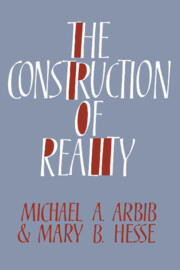Book contents
- Frontmatter
- Contents
- Preface
- Chapter 1 Posing the problem
- Chapter 2 The intelligence of the artificial
- Chapter 3 Schema theory
- Chapter 4 Relating mind and brain
- Chapter 5 Freedom
- Chapter 6 Freud on psychology and religion
- Chapter 7 Schemas: from the individual to the social
- Chapter 8 Language, metaphor, and a new epistemology
- Chapter 9 Interpretation and reality
- Chapter 10 Religions as social schemas
- Chapter 11 The Great Schema
- Chapter 12 Secular schemas
- References
- Author index
- Subject index
Chapter 11 - The Great Schema
Published online by Cambridge University Press: 22 September 2009
- Frontmatter
- Contents
- Preface
- Chapter 1 Posing the problem
- Chapter 2 The intelligence of the artificial
- Chapter 3 Schema theory
- Chapter 4 Relating mind and brain
- Chapter 5 Freedom
- Chapter 6 Freud on psychology and religion
- Chapter 7 Schemas: from the individual to the social
- Chapter 8 Language, metaphor, and a new epistemology
- Chapter 9 Interpretation and reality
- Chapter 10 Religions as social schemas
- Chapter 11 The Great Schema
- Chapter 12 Secular schemas
- References
- Author index
- Subject index
Summary
Myth and history
In this chapter, we turn to consider explicitly the Bible as religious text, regarding this as a complex and holistic symbol system that, roughtly speaking, constructs the worlds of Judaic and Christian religion. We have two purposes in mind here. First, we want to exhibit some workings of a symbol system in this particular case. Second, we want to use the Bible to address two problems that have dogged our discussion of schemas and symbolisms throughout: the problems of relativism and transcendence. Can Biblical religion be seen as anything but another functional or chance manifestation of particular societies at particular times, or can we give some sense to its claim to universality, to be speaking truly of a transcendent God?
In considering the Bible as an internally knit symbol system, we are, of course, following the tradition of hermeneutics in social theory (of which indeed Biblical hermeneutics was the first example) and in social anthropology. This approach first became explicit in the nineteenth century; it should be noted, however, that in the mainstream of interpretation, the Bible has never been taken only as a “naïve story” or as factual history. The texts established (with more or less minor variations) in the canon by the third century a.d. were already chosen for a variety of theological, moral, and political as well as historical reasons.
- Type
- Chapter
- Information
- The Construction of Reality , pp. 222 - 243Publisher: Cambridge University PressPrint publication year: 1986

